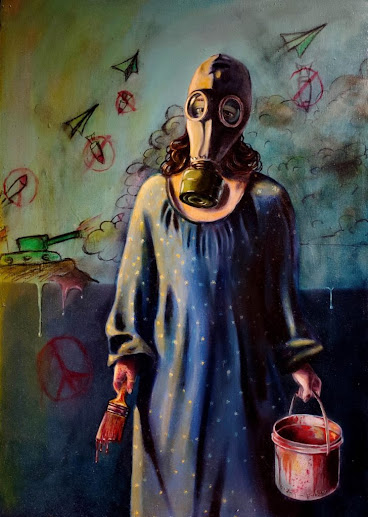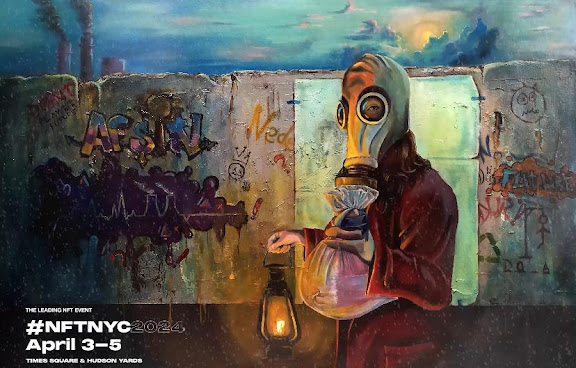*This interview, conducted by Eylül Aşkın, was first published in Turkish on 29.07.2023 on the online art platform sosyeteart.com. https://sosyeteart.com/index.php/2023/07/29/unlulerin-takibindeki-ressam-erdogan-paksoy/
Our guest today is a young artist who has achieved numerous successes at a tender age, making a name for himself through participation in various exhibitions and art competitions, earning accolades. Especially with his recent works, he has become a favorite among celebrities – the acclaimed artist, Erdoğan Paksoy.
How did you discover your interest in drawing and painting? How did you decide to build your career in this field?
My interest in painting has been a constant influence in my life since childhood, serving as a companion on my journey. Creating graffiti on walls and utility boxes with friends, adding drawings and cartoons to my school notebooks – these were the initial steps showcasing my passion for art. However, it never crossed my mind that art would become the center of my life. The turning point that would define my life and lead me into the world of art began in 2013 when I failed to pass the university entrance exam. In the melancholy of not succeeding in the exam, while engaging in drawings, I started sharing my artwork on social media. At that time, pursuing an art degree wasn't even a consideration for me. However, the spark that would change my life came from my primary school art teacher, Jale Güler. Her encouragement and words, "Erdoğan, I must prepare you for the art department. I can see the gems that will emerge from the tip of your pencil," entirely redirected my life, opening the doors to a passionate world of art. Following a six-month art training, I successfully passed the talent exam and gained admission to the Selçuk University Fine Arts Department. Throughout this process, I received tremendous support from my professors, friends, and, above all, my family. Filled with the thought, "Even if I have to go hungry, I will become an artist!" I embarked on this enchanting journey. Art had now transformed from a mere interest into a lifestyle and passion. Currently, I continue to build my career in this field by following my passion.
In today's society, children aspiring to pursue education in fields like art and music at the higher level can become a nightmare for their parents due to concerns about potential livelihood challenges. How was your family's attitude towards you in this field?
Unfortunately, in our country, there is often a bias against departments such as fine arts and music, but I have always believed in the idea that "A person will undoubtedly succeed in the profession they love." Even if the results of perseverance and hard work are not appreciated by people, when the universe begins to appreciate, success will inevitably come on its own. In this context, my family has always supported and encouraged me. Thanks to their encouragement and belief, I was able to progress strongly.
From your resume on your website, I gathered that you have a quite assertive personality. Sending your works to exhibitions and winning your first awards while still an undergraduate student reflects this. Are you as bold in your personal life as you are in your artworks?
Life is an adventure that we experience only once, and it's too short not to feel excited. The greatest joy for me is to try everything and gain experiences from those endeavors. Success is a reward that can be achieved with courage and passion. Therefore, I don't hesitate to take bold steps in my life. Being a bit crazy in these steps can also be quite enjoyable. 🙂
For your Master's thesis in the main art branch of painting, you chose to present a thesis titled "Visual Analyses in the Context of Environmental Pollution." Are you genuinely concerned about issues like ecological imbalance and environmental pollution? Do you carry the protest stance in your art related to these issues in your individual life? Have you collaborated with relevant institutions on such matters, or would you consider it if such an offer came?
Nature is a host that welcomes us with all its beauties. It is the most reliable companion we can seek refuge in. As humanity, we live in the home of nature, yet every time we dirty its home! My love for the beauty of nature allows me to deeply feel its pains. The disruption of ecological balance, environmental pollution, and similar issues genuinely concern me, sparking a constant rebellion within me, full of anguish. I am aware of our responsibility to nature and the environment as part of this world, and I strive to act with this consciousness. My art carries a protest stance, and I take it wherever I can make my voice heard. In my paintings, I reflect the nature harmed by human impact and the dystopian universe resulting from this harmful effect. I express the burning fire within me on this matter through my paintings, aiming to provoke people to think and, through thinking, to take action. I haven't collaborated with an institution on this matter yet, but I would wholeheartedly consider and feel honored to contribute if such an offer came. The power of art can trigger change and raise awareness among people. If there are brave-spirited institutions willing to move forward on this path, I would eagerly collaborate. It's crucial to remember that even small steps can lead to significant changes.
How did you come across the concept of dystopia? Why do you specifically prefer to create works in this field?
My introduction to the concept of dystopia began during my undergraduate years as I sought to discover my own artistic style. I wanted to better understand myself and see the reflections of my inner world in my paintings. Throughout this process, I frequently met with my advisor, the esteemed Prof. Dr. Ahmet Dalkıran, sharing ideas and progressing under his guidance. Witnessing humanity's negative impact on nature alongside the beauty of the world deeply concerned me. The Industrial Revolution increased humanity's adverse effects on nature, distancing us from utopian thoughts with dystopian realities such as environmental pollution and the consequences of nuclear bomb tests. These concerns and anxieties led me to explore the theme of dystopia and choose to produce works in this field. By merging dystopian elements with the real world in my paintings, I aim to question and awaken humanity's future. Creating awareness, emphasizing the importance of preserving our world, and increasing environmental consciousness are my primary goals through my art. Dystopian themes can shape and transform people's thoughts about the future, which is why I choose to focus on dystopia in my art to make viewers reflect and consider the importance of protecting our planet.
When painting, what inspires you or puts you in a certain mood?
My process of creating art can vary moment by moment. I'm a bit crazy... 🙂 Societal issues, injustices, and environmental pollution deeply sadden and anger me. I try to convey these issues with a protest attitude in my paintings. Sometimes, a natural disaster, the destruction of nature for profit, or even the smallest piece of litter on the ground can drive me to paint. Among the sources that inspire me are, of course, other artists. By studying their works, I discover different techniques and ideas, learning new things from them to enhance my own art. In the end, when painting, I not only reflect my inner world but also try to narrate the world around me through my paintings. Everything that inspires me puts me in a creative mood and makes me feel free when painting.
Who are the local and foreign painters and illustrators you admire and draw inspiration from?
I find inspiration in various artists, and there are quite a few I admire. To name a few: Rembrandt, Ivan Shishkin, Petrus Van Schendel. Additionally, artists I mentioned in my thesis and interviewed, such as Tomas Sanchez, Martin Wittfooth, Scott Greene, Constance Mallinson, Karen Hackenberg, and Michael Kerbow. Each of them contributes to my appreciation for diverse artistic expressions.
How do you, as an artist, evaluate the fact that contemporary art receives more criticism compared to modern and classical art, and what are your thoughts on the digitization process in art?
The heightened criticism of contemporary art compared to modern and classical art is actually an indicator of art's continuous evolution. Art has always been open to change and innovation, and contemporary art is a reflection of this ongoing transformation. Critique and reaction contribute to the vitality and progression of art. Contemporary art may employ a different language than traditional art and challenge familiar patterns, which can make it incomprehensible and subject to criticism by some. However, at the core of art lies expression and freedom. Contemporary artists use this freedom to offer different aesthetic and intellectual experiences. Evaluating the digitization process in art, it has undoubtedly added a new dimension, triggering criticism as well. Yet, considering the intrinsic nature of art, it should be remembered that it undergoes transformation and questioning in every era. Criticizing digital art and contemporary art is, in essence, an indication of the vibrancy of the art world. As a part of contemporary art, I appreciate art's constant transformation, freedom, and diversity. In creating my art, I strive to be open to criticism while producing something unique that reflects the spirit of the age and utilizes technological possibilities.
In the upcoming season and in 2024, where can we expect to see your works, and do you have any thoughts about expanding to Europe following the success you've achieved in Turkey recently?
Making plans is great, but sometimes savoring the moment is important too. As an artist, I appreciate a spontaneous and surprising life. Not only opening up to Europe but to the whole world! Psst, let me share a secret, beautiful things are on the way! 🙂
What could be your most utopian dream in professional terms?
Painting while enjoying the view of Earth from the moon.
Are there other art forms that you are interested in or follow besides painting?
Certainly! Music and photography. In fact, when I was 15-16 years old, I used to write and perform rap songs and even took the stage. Currently, I play the electric guitar and immortalize moments through photography.
Where can our readers follow you on social media?
To see my paintings and moments: www.instagram.com/erdoganpaksoy
To read my thoughts and a bit of my rebellious side: www.twitter.com/erdoganpaksoy
Since 2018, NFTNYC has been a prominent event in the United States, bringing together leading figures, developers, and artists in the digital art and NFT (non-fungible token) realm. This year, Turkish painter Erdoğan Paksoy is honored to be one of the featured artists at this prestigious gathering, where collaborative works and values in the digital art space are celebrated.







Comments
Post a Comment